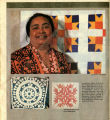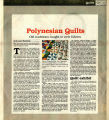| OCR Text |
Show Polynesian Quilts Old traditions caught in new fabrics By Pr. Joyce Hammond • Dr. Hammond teaches anthropology at Illinois State University and will soon publish a book on Polynesian quilts. THOUGHTS OF POLYNESIAN cultures often bring to mind hulas, leis, and ukuleles. Although one may not think of quilts, Polynesian women have been making applique and piecework textiles since the late nineteenth and early twentieth centuries when Christian missionaries introduced Western quilts into the islands. The Polynesian fabric expressions represented by the Polynesian quilt exhibit at the Utah Museum of Natural History are a unique combination of Western quilting and indigenous Polynesian barkcloth traditions. Barkcloth, created from the inner bark of the mulberry tree, was made throughout Polynesian and used for clothing, bed-covering, and room partitions. It was also a valuable commodity and of great importance in many ritual and religious ceremonies. When explorers, missionaries, and settlers brought Western fabric to the islands, Polynesians in some islands began to replace the ceremonial functions of barkcloth with applique and piecework textiles modeled on Western quilts. The applique and piecework of the Society Island, known as tifaifai, and the applique quilts of the Hawaiian Islands (sometimes called kapa) are still used there in rituals such as weddings and farewell ceremonies for church and political officials. In Utah, as in the islands, Hawaiian quilts and Society Islands tifaifai are prized gifts and often serve as decorative bedcovers spread open for display only on special occasions. Very few women from the Society and Hawaiian Islands who live in Utah make tifaifai or kapa because the textiles require considerable expenditures of time and money. Large quantities of material are required for the applique designs and their contrasting backgrounds. It may take a woman a year to complete a Hawaiian quilt because the quilting patterns follow the outline of the design over the entire surface of the quilt. In the Samoan and Tongan Islands, women never ceased making barkcloth for ceremonial purposes. Consequently, piecework and applique textiles have historically played less important roles among western Polynesians. In Utah, as in the Samoan Islands, Samoan women rarely make piecework or applique. Three Tongan quilts. Fan, Manulua and Pineapple reflect portions of the Tongan culture and were made by immigrant Tongans living now in Utah. Although women in the Tongan Islands create comparatively few quilt-like textiles as a result of the continued importance of barkcloth and a shortage of Western fabric, many Tongan women in Utah create piecework "monomono." Unlike Society Islands tifaifai and Hawaiian quilts made in Utah - which are indistinguishable from those made in the islands - Tongan monomono made in Utah often differ from those made in the Tongan Islands. Western fabric is still very expensive in the islands, and island women fashion monomono from a limited range of scrap fabric. In Utah, Tongan women have a much wider range of fabric types and colors with which to create different kinds of designs. There is also greater access to pattern books and design ideas in this country. Many Tongans trade or sell monomono made here to their relatives and friends in the islands. Tongan women in Utah emphasize practicality in monomono. They value the practical qualities of synthetic fabrics for their durability and color-fastness. Many Tongans use new fabric scraps which they obtain free or at little cost from factory and store outlets to make the piecework designs of the monomono. The piecework style of Tongan monomono also has parallels to Tongan ngatu (barkcloth) designs. Historical and contemporary Tongan barkcloth made in the islands is decorated with repetitive patterns, many of which are geometric and applied semimechanically with stencils. The repetitive, patterned designs of Tongan monomono appear to be an extension of Tongan barkcloth aesthetics^ Like much Tongan barkcloth, the machin"e*sewn and yarn-tied construction of many Tongan monomono also emphasizes quantity rather than attention to detail. Imported ngatu (barkcloth) and fiber mats are the most highly prized material possessions of Tongans in Utah, but monomono are beginning to take on new significance in the Tongan culture of Utah. Presented as gifts in weddings, birthdays and even funerals, monomono sometimes supplement the valued barkcloth and mats in a manner not commonly found in the Tongan Islands. Along with barkcloth, mats and money, mono-mono quickly pass from hand to hand in the extensive system of material exchanges which are a part of Tongan rituals. As a result, many Tongan women keep several tops of monomono on hand to finish as the need arises. Despite their differences, Society Islands tifaifai, Hawaiian qyilts and Tongan monomono share the use of symmetry and bold color, and often reflect the feelings and experiences of the Polynesian people. The Polynesian piecework and applique textiles in this exhibit are a symbol of the adaptability and creativity of the Polynesians who now call Utah home. Quilt exhibit An exhibit of quilts made by Polynesians in Utah begins at the Utah Museum of Natural History Dec. 10. An opening celebration Dec. 9 at 7:30 p.m. will feature a Tongan brass band, a traditional Tongan feas*, and music and dance performed by the Kinikini family. Cost is $10 and limited reservations are being taken by the museum, 581-6972. The free public opening, Dec. 10 from 1 to 5 p.m. features traditional entertainment, demonstrations and refreshments. A children's opening from 10 to 12 will feature Moana AUen teaching ancient HawaiianHula and Hawaiian crafts. Reservations are limited, but available from the museum. The quilt exhibit will run through Jan. 15, 1984. After that, they will tour the state as part of the Utah Arts Council's exhibition Touring Program. This project is sponsored by the Utah Folklife Center, Utah Arts Council, and Utah Museum of Natural History with support from the Utah Endowment for the Humanities. . • . . • • • • . • • . • • • • \ ; • - . • • . v • : • : • ' • ' . ' ' . ' • • • •';: 7 7 • • ' •'•' |





